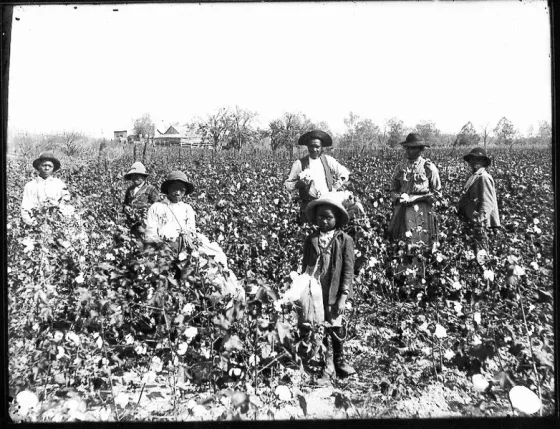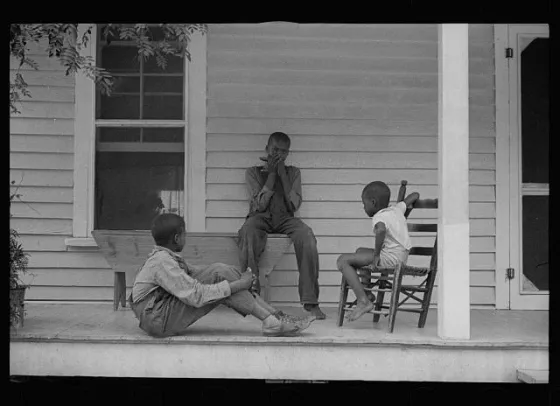
Cotton pickers on Mileston Plantation; Mississippi Delta, Mississippi.
On December 6, 1865, the United States ratified the Thirteenth Amendment:
Neither slavery nor involuntary servitude, except as a punishment for crime whereof the party shall have been duly convicted, shall exist within the United States, or any place subject to their jurisdiction.
With this Amendment, the economic slave-based system of the South was deemed unconstitutional. The South’s GDP, which was largely based in slave ownership and trade, disappeared as African Americans ceased to be property and were acknowledged as human beings. Plantation owners with large patches of land found themselves with no workers nor funds to pay for labor. Newly freed African Americans were able to enjoy freedom for the first time but had no property nor money in order to make a living. In order to remedy the precarious economic system in the South, sharecropping was introduced.
After the Civil War, the Freedmen’s Bureau, formally known as the Bureau of Refugees, Freedmen, and Abandoned Lands was established. The Bureau was created by the government in order to allocate resources, such as food and medical supplies to newly freed slaves. In addition, the Bureau could organize the reallocation of confiscated land by Confederates to freed people and assist freed people in earning a living after the war. Because of its temporal status and budget constraints, the Bureau’s reach and control were limited. Originally, the Bureau suggested forming freedmen into groups and creating a gang-labor system to amend the economic problems in the South. This labor formed freedmen into multiple groups, or gangs, and assigned each gang a different task. These gangs were managed by one field manager or a group of field managers. Gangs were paid by the field managers when their assigned tasks were completed. Many freed people did not want to partake in this system. This type of labor gave the manager or managers complete control over the gang with little oversite. It was also commonly used, and abused, by plantation owners on plantations to force field slaves to work long hours with physical punishments if they didn’t complete their tasks. Because of these complaints, sharecropping was adopted by the Bureau instead of gang-labor.

Sharecropping was an economic system that existed before the Civil War and throughout the world. Both white and African Americans became sharecroppers. This system was comprised of sharecroppers renting farmable land from farmers, such as plantation owners, who owned large patches of land. In addition to this land, sharecroppers rented supplies and equipment from the farmer to work the land. Usually, cash crops, like tobacco and cotton, were grown. Depending on the contract, the sharecropper gave half of their harvest or half of the proceeds from selling their harvest to the farmer in lieu of rent. From the remaining proceeds, the sharecropper paid back the sum of the rented supplies and equipment, usually with interest. Any leftover income was kept by the sharecropper. The benefits of this system were that a farmer without disposable wealth, which could be used to buy farmland or equipment, could still become a farmer and make a living. In addition, a farm owner could gain income from farmland he did not have the time or the income to farm themselves. Ideally, the sharecropper could earn enough income each year to save a percentage until they could buy their own land. In addition, the sharecropper had the freedom to decide when they wanted to work, how long they wanted to work, and what crops they wanted to plant.
Ideally, sharecroppers were able to become share-tenants and cash-tenants. Share tenants rented land from a large-scale farm, just like sharecroppers. However, share-tenants owned their own equipment and supplies or were able to buy their own equipment and supplies. Depending on their contract, share-tenants gave one-half to one-third of their harvest or one-half to one-third of the proceeds from selling their harvest to the farmer they rented land from in lieu of rent. The remaining proceeds were kept by the share-tenant. Generally, share-tenants made more profit than sharecroppers since they did not have to pay interest on supplies or equipment rentals. Cash-tenants were like share-tenants, except cash-tenants paid a monetary amount of rent for the property annually instead of giving one-half of the harvest in lieu of rent. This system allowed the tenant to keep the entirety of their crop and could reap higher rewards, or financial burdens, in the marketplace when they sold their crops.
However, the system became exploitative to sharecroppers. Farmers with large patches of land, such as old plantation farmers, established a “Plantation Store” on their property. These farmers required all sharecroppers farming on their land to use their store for farming equipment and personal shopping. Prices in these stores were highly inflated. Stores encouraged sharecroppers to buy items with “credit.” In this system, called “crop lien,” the stores charged excessive interest rates on items bought with credit, which could be as high as 15% interest per month. Since many sharecroppers did not have enough disposable income to purchase items during the year, many used this credit extensively. Because of these high interest rates, many did not have disposable income after they paid off their credit line. If the harvest was poor, some sharecroppers remained in debt to the store until the next year.
With these exploitative stores, many sharecroppers couldn’t become fully “free” in this system. With mounting debts, farmers prioritized cash crops and could not spend time planting personal gardens for daily food consumption. Since these cash crops were time-intensive, sharecroppers’ children were pulled from schools and were unable to access an education. Because of poor harvests, farmers could not make enough income to buy their own land or start a savings account. Eventually, this type of situation was labeled “wage slavery.” “Wage slavery” is a term that refers to individuals who are only earning subsistence wages, which means their wages only cover their basic needs. This term was used in future labor protests throughout the late nineteenth and early twentieth century protests.

Sharecropping began to wean as a labor-system in the 1930s. Once large-scale automation was introduced to farming, farmers could plant and harvest larger patches of land for less money in less time. Buying machines became a more profitable venture than paying sharecroppers to farm smaller plots of land by hand. In addition, decades of poor labor practices left thousands of acres of land inhospitable to farming. These practices led natural disasters, such as the Dust Bowl, that scattered dust throughout the Great Plains, destroyed plant and animal life, and made the area uninhabitable. Some sharecroppers did benefit from this labor system. Farmers were able to dictate their own hours, what to plant and where to plant their crops. Women were able to play a more active role in the home since they were able to devout time away from fields and crop cultivation. Schools and communities were established near dense clusters of sharecroppers for educational and social enrichment. Ideally, sharecropping was a beneficial labor system that could create upward mobility for newly freed African Americans. In reality, the sharecropping system was the site of exploitation and economic stagnation that only benefited few.





